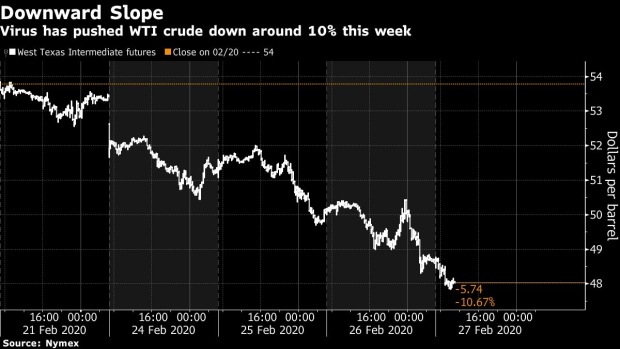Feb 26, 2020
Oil Extends Slump Past 13-Month Low on Mounting Pandemic Fears
, Bloomberg News

(Bloomberg) -- Oil extended losses after closing at a 13-month low as more new coronavirus cases were reported outside China than within, adding to fears the world is on the brink of a pandemic that will take a hefty toll on growth.
President Donald Trump failed to calm markets at a briefing on the outbreak, with Asian equities declining and crude tumbling to $48 a barrel after the U.S. reported its first infection of unknown origin. New cases were diagnosed in countries from Pakistan to Brazil, Germany said it was likely at the start of an epidemic and Saudi Arabia halted religious visits.
U.S. data that showed a smaller-than-forecast increase in crude stockpiles failed to arrest the slide. Oil has now fallen 21% this year as the virus hit a market already awash with supply. Investors are hoping that the Organization for Petroleum Exporting Countries and its allies will be able to agree on deeper output cuts at a meeting in Vienna next week.
“The coronavirus showing up in the U.S. is a huge concern,” said Stephen Innes, chief market strategist at AxiCorp. “The pressure on OPEC is immense and the oil market is really testing their resolve right now.”
West Texas Intermediate futures for April delivery fell 1.4% to $48.04 a barrel on the New York Mercantile Exchange as of 10:54 a.m. in Singapore, after dropping 2.3% on Wednesday to close at the lowest since Jan. 7, 2019.
Brent lost 1.2% to $52.79 a barrel on the ICE Futures Europe exchange following a 2.8% drop in the previous session. The global crude benchmark traded at a $4.75 premium to WTI.
President Trump said Vice President Mike Pence will lead the U.S. government’s response to the virus and that the risk to the American people remained “very low.” Minutes after Trump concluded his remarks, the Centers for Disease Control and Prevention announced it had identified the first coronavirus case in the U.S. of unknown origin. The California patient hadn’t traveled to China or had contact with other known victims of the disease, it said.
U.S. crude stockpiles rose by 452,000 barrels last week, the Energy Information Administration reported, compared with analysts’ forecasts for a 2.6 million barrel increase. Inventories have now risen for five straight weeks, while American oil production stayed at a record high. There may soon be a supply response from U.S. shale drillers, given the break-even point for most of them is $46 to $48 a barrel, Innes said.
--With assistance from James Thornhill.
To contact the reporter on this story: Ann Koh in Singapore at akoh15@bloomberg.net
To contact the editors responsible for this story: Serene Cheong at scheong20@bloomberg.net, Andrew Janes, Aaron Clark
©2020 Bloomberg L.P.

